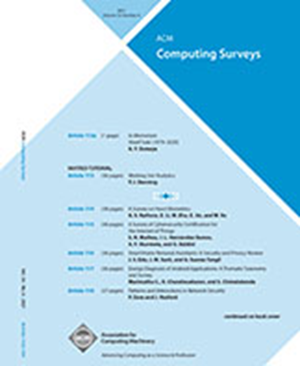概率程序的切片:对现有方法的回顾
IF 28
1区 计算机科学
Q1 COMPUTER SCIENCE, THEORY & METHODS
引用次数: 0
摘要
程序切片的目的是在保留程序行为的同时,通过识别和删除不必要的部分来简化程序。它被广泛用于程序理解、调试和软件维护。本文概述了概率程序的切片技术,它将传统的编程结构与随机抽样和条件作用相结合。近年来,由于人工智能和差异隐私等领域的新应用,这些程序经历了显着的复苏。具体来说,我们回顾了目前可用于概率程序的三种主要切片技术:Hur等人的基础技术,Amtoft和Banerjee基于概率控制流图的后续发展,以及Navarro和Olmedo基于程序规范的最新方法。我们提供了这些技术的清晰、可访问和自包含的演示,并在多个维度上对它们进行比较,以提供对概率程序切片中当前最先进技术的更深入的了解。本文章由计算机程序翻译,如有差异,请以英文原文为准。
Slicing of Probabilistic Programs: A Review of Existing Approaches
Program slicing aims to simplify programs by identifying and removing non-essential parts while preserving program behavior. It is widely used for program understanding, debugging, and software maintenance. This article provides an overview of slicing techniques for probabilistic programs, which blend traditional programming constructs with random sampling and conditioning. These programs have experienced a notable resurgence in recent years due to new applications in fields such as artificial intelligence and differential privacy. Concretely, we review the three major slicing techniques currently available for probabilistic programs: the foundational technique by Hur et al., the subsequent development by Amtoft and Banerjee based on probabilistic control flow graphs, and the more recent approach by Navarro and Olmedo based on program specifications. We provide a clear, accessible, and self-contained presentation of these techniques, and compare them across multiple dimensions to provide a deeper insight into the current state-of-the-art in probabilistic program slicing.
求助全文
通过发布文献求助,成功后即可免费获取论文全文。
去求助
来源期刊

ACM Computing Surveys
工程技术-计算机:理论方法
CiteScore
33.20
自引率
0.60%
发文量
372
审稿时长
12 months
期刊介绍:
ACM Computing Surveys is an academic journal that focuses on publishing surveys and tutorials on various areas of computing research and practice. The journal aims to provide comprehensive and easily understandable articles that guide readers through the literature and help them understand topics outside their specialties. In terms of impact, CSUR has a high reputation with a 2022 Impact Factor of 16.6. It is ranked 3rd out of 111 journals in the field of Computer Science Theory & Methods.
ACM Computing Surveys is indexed and abstracted in various services, including AI2 Semantic Scholar, Baidu, Clarivate/ISI: JCR, CNKI, DeepDyve, DTU, EBSCO: EDS/HOST, and IET Inspec, among others.
 求助内容:
求助内容: 应助结果提醒方式:
应助结果提醒方式:


